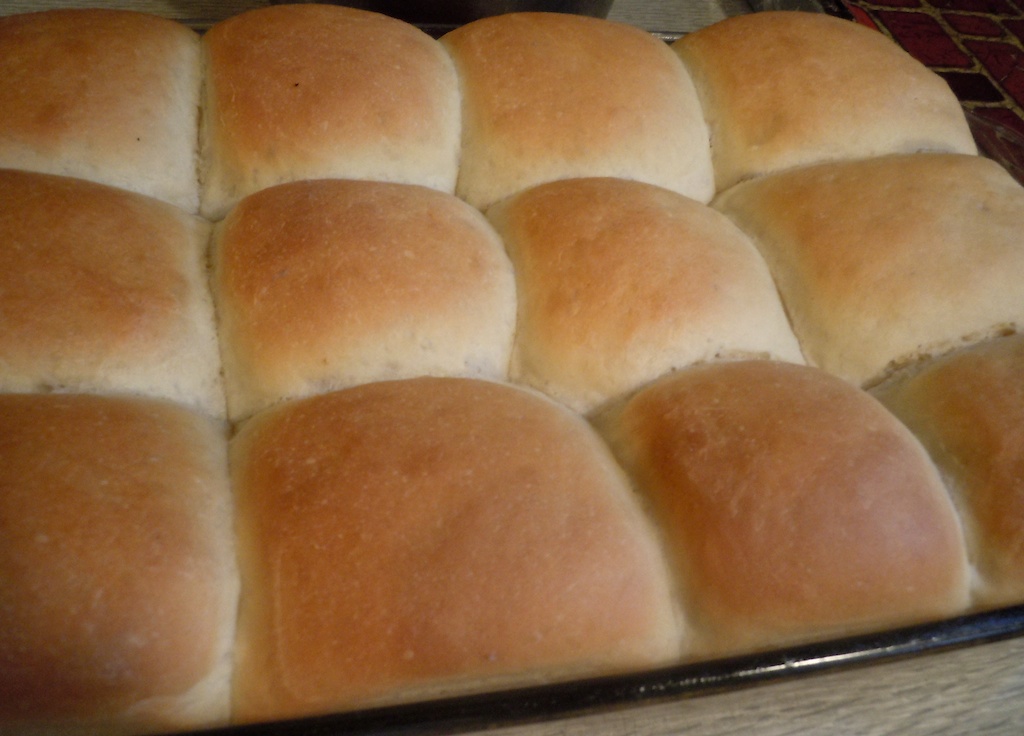 I cannot begin to write about my mother’s bread making without mentioning her kneading. And I would have to begin any discussion of her kneading by describing her hands. My mother is not, nor has she ever been, a delicate doily of a damsel, and neither are her hands. Big, rough and muscular are not the usual attributes of lady hand, but they belong to my mother’s, and I consider her a lady of the highest order.
I cannot begin to write about my mother’s bread making without mentioning her kneading. And I would have to begin any discussion of her kneading by describing her hands. My mother is not, nor has she ever been, a delicate doily of a damsel, and neither are her hands. Big, rough and muscular are not the usual attributes of lady hand, but they belong to my mother’s, and I consider her a lady of the highest order.
 They say married folks often resemble each other or, over time lived together, take on similar physical characteristics. This can only be found in one feature of my parents — their hands. For a lady and man to have the same hands may sound strange, but somehow, seeing them, it makes sense. Both my mother and father began and made their lives out of these broad, long-fingered tools. That’s what many people, at least my people, used to do.
They say married folks often resemble each other or, over time lived together, take on similar physical characteristics. This can only be found in one feature of my parents — their hands. For a lady and man to have the same hands may sound strange, but somehow, seeing them, it makes sense. Both my mother and father began and made their lives out of these broad, long-fingered tools. That’s what many people, at least my people, used to do.
They are work hands, as much to be admired for their physicality as ability. My mother’s hands have — among many hundreds of accomplishments — both threaded a needle and shot a gun (my mother’s nickname was Annie Oakley). They have held the rein and mane of horses ridden across the prairie. They have slain, plucked, skinned and gutted innumerable wild and domestic animals. They have chopped and stacked wood, planted gardens and trees, ran a roto tiller, dug graves, painted walls and torn them down. Dislodged eggs from egg-bound chicken hens. They have swatted dead flies, spiders, wasps and bees. Seined bait and reeled in fish. Rowed a boat. Caught a wayward pet sparrow during an impending tornado. Applied pressure to a child’s recurring nosebleeds. Brushed a tangle of fine body length hair. Climbed a ladder. Climbed a tree. Picked berries, fruits, wild mushrooms, garden produce. Shell peas, husk corn, snap beans, pit cherries. Drawn cartoon rabbits in crayon on easter eggs. Pumped life back into a husband lying lifeless on the bathroom floor.
Her hands were rarely painted or manicured and, to my knowledge — even though the attempts may have been made — never played the piano, crocheted or did needlework. But they have been burned, shocked by high-voltage, bitten by fangs and beaks, cut by everything from knives to catfish barbs.
Her hands have cooked — and continue to — a lot. All sorts of things. Mostly from scratch. She is old-school in the ultimate sense, using hands to can vegetables, make jams, bake pies (including crust) and make bread.
So, in my good fortune to be able to still return to the home where I grew up and see the people from whom I came. I made a simple, yet profound request of my mother and her hands. I wanted her to make bread.
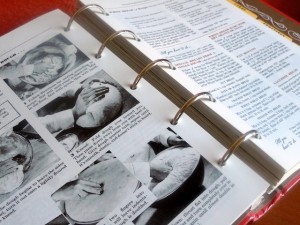 My mother has made good bread for years, and while trying and succeeding at a variance of recipes, always returns to the same simple white bread recipe she has turned into loaves, cinnamon rolls, dinner rolls and a fried bread she has always called “skonkz,” that she learned how to make from her German mother. The rolls, particularly the cinnamon rolls, were often wrapped in tinfoil, bedecked with a single bow and handed out as gifts.
My mother has made good bread for years, and while trying and succeeding at a variance of recipes, always returns to the same simple white bread recipe she has turned into loaves, cinnamon rolls, dinner rolls and a fried bread she has always called “skonkz,” that she learned how to make from her German mother. The rolls, particularly the cinnamon rolls, were often wrapped in tinfoil, bedecked with a single bow and handed out as gifts.
She is not quire sure of the origins of the recipe, but believes it was adapted from “Betty Crocker’s Picture Cook Book” (1950), which, to note, was one of AWS’s favorite childhood books!
The fact that my mother honored my recent request of making her bread is one thing; the fact that she honored it on the “coolest” of recent 90-degree June mornings shows, to me, what AWS knows — beyond life, there is no greater gift of love than food.
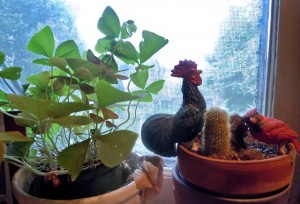 On our summer morning of bread baking, we were ready and fueled by my mother’s coffee, so dark and bold, my father claims you can “stand a spoon in it.” Birds chorused and called through the high kitchen windows, open to pull in any breath of cool. Beyond yeast, which my mother already had on hand, no special ingredients needed to be gathered for the bread making.
On our summer morning of bread baking, we were ready and fueled by my mother’s coffee, so dark and bold, my father claims you can “stand a spoon in it.” Birds chorused and called through the high kitchen windows, open to pull in any breath of cool. Beyond yeast, which my mother already had on hand, no special ingredients needed to be gathered for the bread making. 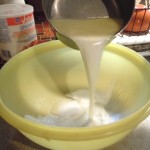 My mother took her largest bowl — yellow and Tupperware and many moons old — the bowl she always used, and began the process, mixing salt and sugar in the bowl and adding to that heated milk in which both butter and shortening had been melted. Two packets of dry yeast are sprinkled in. Enough flour was added to create the consistency of pancake batter. Then stirring (in one direction, she emphasizes),
My mother took her largest bowl — yellow and Tupperware and many moons old — the bowl she always used, and began the process, mixing salt and sugar in the bowl and adding to that heated milk in which both butter and shortening had been melted. Two packets of dry yeast are sprinkled in. Enough flour was added to create the consistency of pancake batter. Then stirring (in one direction, she emphasizes),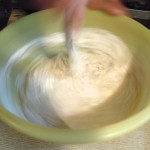 lots of it, 10 minutes worth (I had not realized it was so lengthy) or, as my mother put it, “.until my damned arm gets tired.”
lots of it, 10 minutes worth (I had not realized it was so lengthy) or, as my mother put it, “.until my damned arm gets tired.”
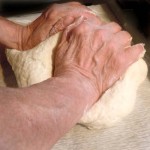 Then, she continued to add flour until she could stir no more. The dough was turned out onto a floured board, covered and allowed to rest, then it was kneaded for 10 minutes. Here I must say that, like many modern bread bakers, I am a squeamish hand kneader and yet I come from a woman who kneads with those powerful hands, unyielding and untiring in the process. Kneading is an important step in most yeast breads, giving air, life and enhancing a textural protein known as gluten to the bread you are creating. The basic kneading process is folding the dough over toward you and pushing it away, then giving the dough a quarter turn. You knead until the dough has a certain feel, my mother said (good bakers are often deliberately vague with the mysteries of their craft). She pushed, pulled and turned the dough with her usual full body rhythm, causing the bread to succumb and the work board to bounce. An occasional “whew” and a few drops of sweat were all that seem to come from her until she announced the dough “feels right.” It’s warm, she said. I touched it…fleshy and pliable.
Then, she continued to add flour until she could stir no more. The dough was turned out onto a floured board, covered and allowed to rest, then it was kneaded for 10 minutes. Here I must say that, like many modern bread bakers, I am a squeamish hand kneader and yet I come from a woman who kneads with those powerful hands, unyielding and untiring in the process. Kneading is an important step in most yeast breads, giving air, life and enhancing a textural protein known as gluten to the bread you are creating. The basic kneading process is folding the dough over toward you and pushing it away, then giving the dough a quarter turn. You knead until the dough has a certain feel, my mother said (good bakers are often deliberately vague with the mysteries of their craft). She pushed, pulled and turned the dough with her usual full body rhythm, causing the bread to succumb and the work board to bounce. An occasional “whew” and a few drops of sweat were all that seem to come from her until she announced the dough “feels right.” It’s warm, she said. I touched it…fleshy and pliable.
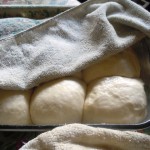 She suddenly put all the kneading work into perspective, and brought up my great-aunt, Clara, who was born with only one arm and made the most astounding bread. If a one-armed woman could knead bread (as well as raise children, fry chicken and hang clothes on the line) who are we of two hands to complain? About anything?
She suddenly put all the kneading work into perspective, and brought up my great-aunt, Clara, who was born with only one arm and made the most astounding bread. If a one-armed woman could knead bread (as well as raise children, fry chicken and hang clothes on the line) who are we of two hands to complain? About anything?
The dough went back into the yellow bowl, which had been washed and oiled, and was covered with a clean towel, then allowed to raise double in bulk, which, in the high heat was easy to arouse.
The bread dough was punched down and kneaded again, just enough, “to knock the air out of it,” three to four minutes. Then it was shaped into rolls and placed in a greased baking dish. My mother has almost always preferred a glass baking dish for both rolls and loaves. She fashions her rolls farm-style (meaning huge!) — and upon rising, one roll equals about three of “normal” stature.
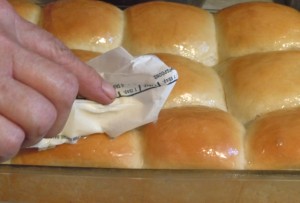 The rolls were baked for about 20 minutes at 350 until a lovely golden brown. Then my mother employed her signature technique of basting the hot fresh rolls with a stick of slightly softened butter or margarine, which gave them an alluring and aromatic sheen. Normally, a towel would then be thrown over the rolls or bread to allow them to “sweat.” We did not antagonize ourselves a moment longer with that step but instead pulled them, hot from the pan, to be eaten, unsweated. My mouth sank deep into soft, lovely memory, — rich, full, buttery with the warmth of life and work. Nothing like them.
The rolls were baked for about 20 minutes at 350 until a lovely golden brown. Then my mother employed her signature technique of basting the hot fresh rolls with a stick of slightly softened butter or margarine, which gave them an alluring and aromatic sheen. Normally, a towel would then be thrown over the rolls or bread to allow them to “sweat.” We did not antagonize ourselves a moment longer with that step but instead pulled them, hot from the pan, to be eaten, unsweated. My mouth sank deep into soft, lovely memory, — rich, full, buttery with the warmth of life and work. Nothing like them.
I inherited my parents’ hands, but they have been unremarkable in their workload by comparison, save a few million or so typed words over the years, a batch of this or that pulled from the oven, a hole or two dug.
There is so much work yet to be done.

Nancy Howard’s White Bread (Dinner Rolls)
Makes 12 large rolls
1 tablespoon salt
2 tablespoons sugar
2 pkgs. active dry yeast
2 cups milk
2 tablespoons butter
1 tablespoon shortening
Approximately 7 cups of all-purpose flour
In a medium saucepan over low heat, warm milk until butter and shortening are melted, allow to cool to lukewarm temperature. Place salt and sugar in a large mixing bowl. Pour in milk mixture, then sprinkle in yeast. Add enough flour to bring mixture to a pancake batter consistency, stirring with a wooden spoon. Continue stirring for 10 minutes or until very smooth.
Begin adding flour in small amounts incorporating well after each addition. When enough flour is added, one will not be able to stir with a spoon any longer. At this point, turn out onto a floured board, cover with bowl and let rest for a few minutes. Begin kneading and continue until the dough is smooth and elastic, about 10 minutes.
Place dough in an oiled bowl, cover with a clean towel and allow it to rise until doubled in bulk, about one hour. Punch dough down and return to floured board. Knead again or 3 to 4 minutes.
Divide dough into 12 equal portions, shape into rolls (use two hands to pull each piece into a smooth round, tucking ends underneath), placing them in a greased 13- by 9-inch pan. Cover with a clean cloth and let rise 45 minutes or so, until double in size. Bake rolls approximately 20 minutes at 350 degrees until a golden brown. Brush or baste tops with butter or margarine.